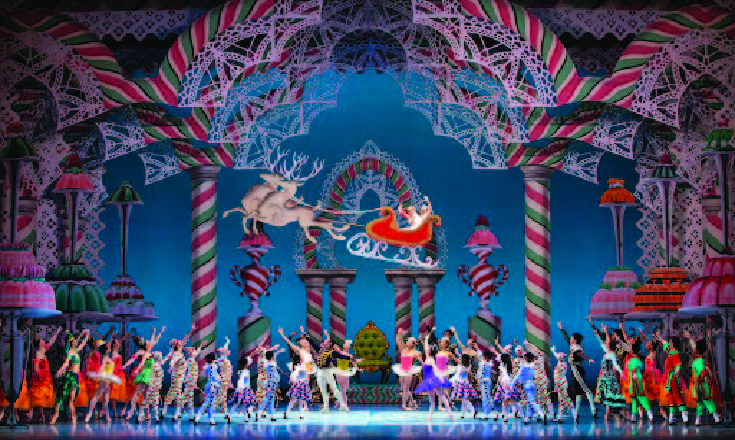
Photo Credit: Photo © Angela Sterling.
Review of PNB’s The Nutcracker
Written by Duncan Barlow, 11/30/2018
The Nutcracker has a certain magic to it no matter how impressive the production and no matter what the quality of the dancers or musicians is. There’s just something to it that feels like gentle warmth from a fireplace, or a soothing mug of tea. However, Pacific Northwest Ballet’s production of George Balanchine’s The Nutcracker is of extraordinarily high quality, and the magic is heightened by the depth of the performance. With an enormous cast, impossible sets, dazzling costumes, and a flawless orchestra, PNB has managed to build as close to a perfect production as I could imagine.
The sets… are simply incredible. Ian Falconer, the set and costume designer, has exceeded expectations over and over again in the first act alone.
Act One:
Party
This version of the ballet starts with Tchaikovsky’s “Petite Overture” and a film depicting a travel through snowy pine trees and little villages, ending just inside the foyer of the Stahlbaum house as the inside is being carefully decorated for a Christmas party. The silver screen goes up, and we are introduced to Clara Stahlbaum, a young girl asleep in the foyer. During the party, guests and their children all dance and celebrate. Clara’s chaotic-neutral godfather Drosselmeyer arrives with his nephew Nathaniel, who Clara develops a bit of a crush on. On opening night, Clara was Zoe Alvarado, a student at the Pacific Northwest Ballet School, just like Jack Kaspar, who played Nathaniel. The students were wonderful at both silent acting and mime, as well as dancing. Drosselmeyer was performed by Seth Orza, pulling gasps and laughs from the audience without coming across as campy or false.
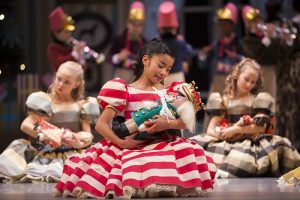
Clara, with her beloved Nutcracker doll.
The children in the cast are allowed to take center stage without extremely technical dancing; Balanchine made the party scene formation heavy so the children could carry attention without the decades of practice that the adult ballet dancers had.
Drosselmeyer brings several life-sized dolls that dance for the party, but even that isn’t as exciting as the nutcracker he produces. Clara is immediately besotted—the rather ugly doll has stolen her heart. After the party is over, Clara and Nathaniel have to part ways, and Clara is sent to bed. She returns to the main room later that night to recover her beloved nutcracker, and she falls asleep on the couch.
Battle
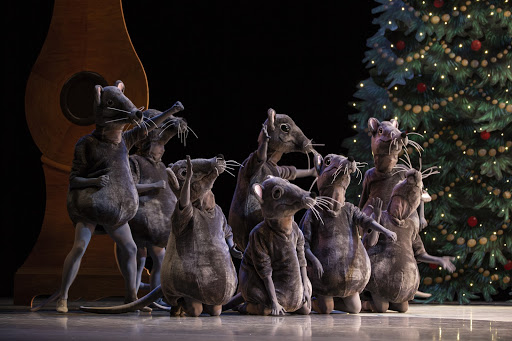
Eek – A mischief of mice! Photo © Angela Sterling
Suddenly, huge mice bounce across the stage, the Christmas tree begins to grow, the windows begin to stretch. Clara is now as big as her nutcracker, and the mice are coming for her. Fritz’s toy soldiers come to life (played by more children from the PNB School), as does her nutcracker, played by a suspiciously familiar dancer. Together they defend Clara from the mouse army, which is led by a Rat King with seven heads, each adorned with a crown. Clara takes off her shoe and throws it at the King, allowing the Nutcracker to defeat the Rat and end the battle.
The Nutcracker is revealed to have been a young prince, played by Jack Kaspar. The scene has changed, and the two children are now in a snowy forest, where ballerinas represent the snowflakes that swirl and flurry in complex formations.
The sets in the Battle and the Snow scenes are simply incredible. The room of the party expands before the audience’s eyes, and then vanishes into a quietly snowy forest seamlessly. Ian Falconer, the set and costume designer, has exceeded expectations over and over again in the first act alone.
Snow

The prominent Christmas star that appears at the end of Act I of Pacific Northwest Ballet’s production of George Balanchine’s The Nutcracker® is presented by renowned artist Dale Chihuly.
The snow scene is a favorite of mine, partly because the music by Tchaikovsky is amazing, and partly because it’s a good example of Balanchine’s corps choreography. The Nutcracker is a grueling performance for many corps dancers, many of which perform in almost every single show. Balanchine preferred that the corps dancers got to DANCE, not just frame the principal dancers. The corps has to be on their game, synchronized, musical, athletic and graceful, quick and precise. The formations must be perfect, as must the short solos. It’s a tough job, but Pacific Northwest Ballet is up to the challenge, especially when they include student members of their Professional Division in the corps to fill out their ranks.
The first act ends with Clara and her Prince holding hands and walking tenderly through the trees, in pursuit of the winter star (a radiant sculpture by Dale Chihuly).
PNB has managed to build as close to a perfect production as I could imagine.
Act Two:
The Land of the Sweets
After a healthy intermission, complete with refreshments and exploration of the decorated lobby, the curtain goes up again. This time we’re greeted by several tiny angels gliding through the fog. These are the youngest dancers in the production, holding candles and traveling in their formations as best as they can. They’re rescued from extended stage time by the principal role of the Sugar Plum Fairy, who dances a solo to the iconic holiday music many associate with malls and cheesy Christmas movies. The music takes on a grander feel in the theater with the live orchestra and the set of sugar and lace. Opening night, the Fairy was danced by Leta Biasucci, a principal dancer with the company. Her dancing has a sensitivity to it, and she moves with such grace that you can almost see her float right off the stage. Her épaulement (a fancy word for the movement of her upper body) furthers the illusion of ease, and you can feel the children of the audience become enraptured; this is something new, something beautiful, something almost spiritual.
Clara and her Prince arrive in a boat, greeted by the entirety of the Land of the Sweets: the exciting Hot Chocolate, the sultry Coffee, the athletic Tea, the energetic Candy Canes, the flute-playing Shepherdesses made from Marzipan, the Polichinelles (little clowns), and the flowers headed by the Dewdrop Fairy. The Prince regales the tale of their journey with an impressive series of precise mime, and, as the Prince and Clara watch, each inhabitant dances for them.
The dance of the Hot Chocolate was fun and thrilling, with an especially impressive costume for the lead woman (played by Margaret Miller, partnered by Steven Loch).
The dance of the Coffee was both powerful and soft. Lindsi Dec uses her impossibly good lines to great effect, displaying flexibility and strength. The peacock costume sparkled and jingled, and Dec’s hand cymbals are invisible to the majority of the audience, which adds a mystery to the dance— “Where is that sound coming from?” I heard a child whisper behind me. Her costume, unlike many Nutcrackers, sidestepped the racism of the Arabian role by referencing the role of the Peacock from PNB’s last Nutcracker by Kent Stowell. It also dodged the possible misogyny of the peacock being held in a cage. Seattle audiences are rightfully too progressive for things like that, and the compromise did a good job of staying true to Balanchine’s choreography while still improving with the times.
Similarly, the Tea dance often includes yellowface or similar racist stereotypes. This version of the show forgoes that, with slight changes to choreography to skip over some of the inappropriate movements. Instead the dance focuses on the athleticism of the male soloist, in this case Kyle Davis, and it works. Newcomers to the ballet are none the wiser, and experienced audience members are relieved by the changes. Dance 2, racism 0.

The Candy Canes
Next comes the Candy Canes, which are essentially a bunch of children framing a male soloist (I saw Ryan Cardea). He has a hula hoop that he jumps through, whipping it around him twice as if it were a jump rope. The dance is short, but the soloist is in the air for most of the runtime.
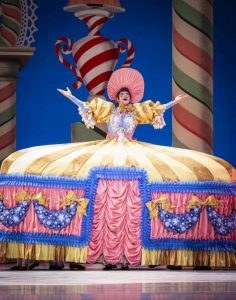
Mother Ginger
The Marzipan Shepherdesses were led by the technically wonderful Angelica Generosa. Their pointe work was precise and satisfying, and Generosa’s pirouettes were stunning. The costumes look like cupcakes and fruit, bouncing a little bit as the dancers perform their petit allegro, or little jumps.
Mother Ginger, a man (Guillaume Basso) in drag and stilts comes out in a gigantic dress, and the little polichinelles hop out from underneath. Always an audience pleaser, Ginger is performed without becoming offensive at any point. Like all good drag artists, Basso provides a subtle caricature, not a campy or crass exaggeration.
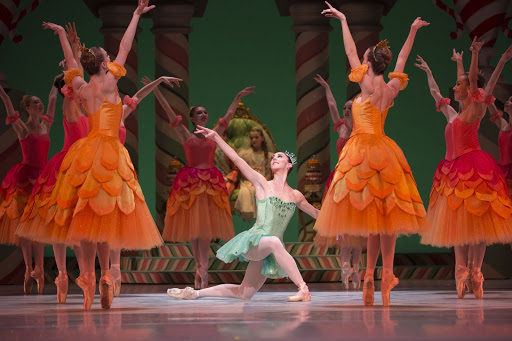
Pacific Northwest Ballet principal dancer Laura Tisserand as Dewdrop, with company dancers in the Waltz of the Flowers from George Balanchine’s The Nutcracker® Photo © Angela Sterling.
Next comes the Waltz of the Flowers, led by Laura Tisserand as the Dewdrop. This is without a doubt my favorite part of the ballet. The music is one of the best compositions I’ve ever heard and never fails to move me. The costumes in this production are warm and full of summer color. The corps dancers are a marvel, bringing Balanchine’s signature formations and precision that were present in Snow and adding a certain depth to it.
The highlight of the dance is the principal role of the Dewdrop. Tisserand darts in and out of the corps formations, with a dazzling smile and an impressive musicality. She plays with the music, interpreting the score in her own individual way. She syncopates her balances, then dashes to the next position, then balances perhaps a count too long!- no, she made it! It was thrilling to watch her chase the music and force it to chase her. An interesting note is that she turned towards the left at one point, exiting off stage left. Most ballerinas in the role turn to the right and exit the other direction. As someone very familiar with the choreography, Tisserand has the capacity to make the role her own. Familiar with the choreography myself, I found her choices exciting and fresh. While other ballerinas may have faster interpretations or higher jumps, Tisserand excels in the balances and her arabesque, and she made artistic choices to favor those aspects of the role.
Finally, the pas de deux (literally “step of two”). A grand pas de deux typically has 4 components: the adage (slow dancing in which the male danseur supports the female ballerina with lifts and helps with balances or turns), the two variations (a solo from the man, then from the woman) and the coda (the exciting ‘finale’ of the pas de deux in which the dancers perform together again in a faster fashion to a musical climax).
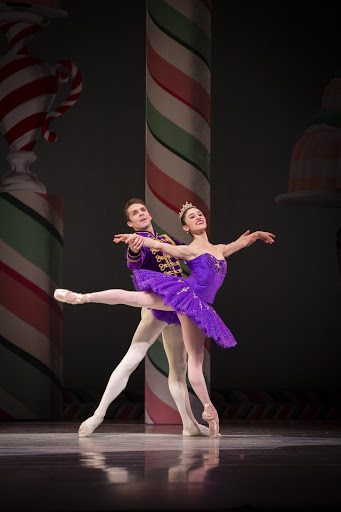
Pacific Northwest Ballet principal dancers Leta Biasucci and Lucien Postlewaite as the Sugar Plum Fairy and her Cavalier. Photo © Angela Sterling.
Balanchine’s Nutcracker skips over the male variation and the woman’s variation is performed at the beginning of Act 2. This leaves the adage and the coda.
Lucien Postlewaite is the Cavalier to Leta Biasucci’s Sugar Plum Fairy in their partnering debut. You would never know it was their first time partnering, though. They moved effortlessly throughout one of Balanchine’s most iconic dances. Lift after lift, pirouette after pirouette, the partnership is successful. Biasucci’s emotions are almost tangible, and the music feels like a bittersweet goodbye to a night of magic. As the music becomes more dramatic, so too does her movement as it speeds up with almost desperate energy, culminating in a breathtaking series of lifts. Then, towards the end of the adage, as the music calms back down, the pair defy physics. The ballerina stands in arabesque en pointe, balancing with one hand in Postlewaite’s careful grip, and he appears to pull her across the stage in that position. This is impossible, of course; Biasucci’s foot should remain where it is by nature of her full body weight resting upon those toes, and she should fall forwards because he’s pulling her hand. But it happens anyway. She glides smoothly. I won’t spoil the magic by telling you the secret, but if you have a sharp eye you’ll be able to catch it.
Next is the coda, with its acrobatic turns and leaps demonstrating the superhuman abilities these dancers possess. Biasucci is again marvelous. She uses her excellent technique to hit all her marks, but the heart of her performance is the way she pulls emotion from the audience without looking like she is acting at all. Dancers are often told not to overact, which can be difficult when the music they dance to is very overpowering. Biasucci resists the temptation to act the emotions out herself, and instead lets the audience feel them.
The finale is next, and dancers from the rest of the act bid little Clara and the young Prince goodbye as they fly off in a reindeer-drawn sleigh. As the curtain falls, the audience begins their standing ovation.
I actually retract my former statement. My favorite part of the ballet is not, in fact, the waltz of the flowers, but instead the children bouncing and twirling out in the lobby after the show. Their enthusiasm was electric, and their giggles filled the halls. I’m sure some little dancers will be finding a studio to join after this inspiring show.
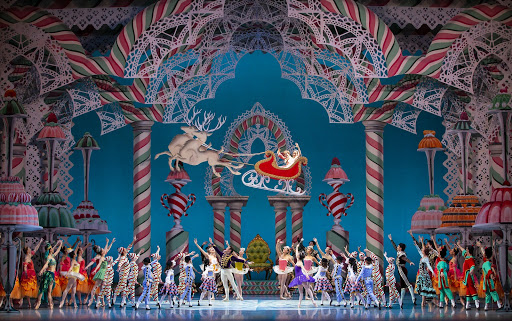
Pacific Northwest Ballet company dancers and PNB School students in the finale. Photo © Angela Sterling.
Pacific Northwest Ballet’s production of The Nutcracker is choreographed by George Balanchine © The George Balanchine Trust. PNB’s production features sets and costumes designed by children’s author and illustrator Ian Falconer (Olivia the Pig) and runs November 23 – December 28, 2018.
All Photos © Angela Sterling, and used by permission of PNB.


